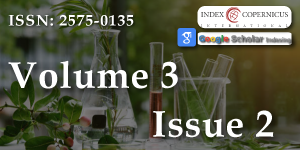Non-chemical control of Armillaria mellea infection of Prunus persica
Main Article Content
Abstract
Peaches, Prunus persica were planted as grafted saplings in an avocado orchard previously infested with Armillaria mellea (Vahl) P.Kumm. Trees were planted in large or small holes with or without fresh yardwaste chips added as an amendment and with or without a Trichoderma biocontrol product sprayed into the hole. Trees were monitored for six years -- growth and mortality was tabulated. Six years later 40% of the trees had died from the disease. Trees planted in a large hole were more likely to survive than in a smaller hole (P=0.07) and trees in large holes with fresh organic matter added were the most likely to survive (P=0.04). Trichoderma sprays in the planting hole did not increase survival rates. While growth was initially retarded by adding fresh yardwaste to the hole, in later years none of the treatments affected growth rates.
Article Details
Copyright (c) 2019 Downer J, et al.

This work is licensed under a Creative Commons Attribution 4.0 International License.
Raabe RD. Host list of the root rot fungus. Armillaria mellea. Hilgardia. 1962; 33: 25-88. Ref.: http://bit.ly/2XnEwns
Shaw CG, Kile GA. Armillaria root disease. Forest Service United States Department of Agriculture. Agriculture Handbook. 1991; 691.
Raabe R. Testing plants for resistance to oak root fungus. California Agriculture. 1966; 20: 12-13. Ref.: http://bit.ly/2xBvvrD
Adaskaveg JE, Förster H, Wade L, Thompson DF, Connell JH. Efficacy of sodium tetrahthiocarbonate and propiconazole in managing armillaria root rot of almond on peach rootstock. Plant Dis. 1999; 83: 240-246. Ref.: http://bit.ly/307ZrYh
Ishii H. Impact of fungicide resistance in plant pathogens on crop disease control and agricultural environment. Jpn Agric Res. 2006; Q. 40: 205–211 Ref.: http://bit.ly/2XHBBW2
Malecka M, Kwasna H, Szewzyk W. Fungal communities in barren forest soil after amendment with different wood substrates and their possible effects on trees, pathogens, insects and nematodes. J of Plant Protection Res. 2015; 55: 301-311. Ref.: http://bit.ly/2NuYxUz
Downer AJ, Crohn D, Faber B, Daugovish O, Becker JO, et al. Survival of Plant pathogens in static piles of ground green waste. Phytopathology. 2008; 98: 547-554. Ref.: http://bit.ly/2Xmj1hM
Munnecke DE, Kolbezen MJ, Wilbur WD. Effect of methyl bromide or carbon disulfide on Armillaria and Trichoderma growing on agar medium and relation to survival of Armillaria in soil following fumigation. Phytopathology. 1973; 63: 1352-1357. Ref.: http://bit.ly/2Jp9pOx
Ohr HD, Munnecke DEBricker JL. The interaction of Armillaria mellea and Trichoderma spp. As modified by methyl bromide. Phytopathology. 1973; 63: 695-973. Ref.: http://bit.ly/306utQq
Munnecke DE, Kolbezen MJ, Wilbur WD, Ohr HD. Interactions involved in controlling Armillaria mellea. Plant Dis. 1981; 65: 384-389. Ref.: http://bit.ly/2xozQhp
Percival GC, Smiley ET, Fox RTV. Root collar excavation with Trichoderma inoculations as a potential management strategy for honey fungus (Armillaria mellea). Arboricultural J. 2011; 33: 267-280. Ref.: http://bit.ly/2J6P1CB
Pellegrini A, Prodorutti D, Pertot I. Uses of bark mulch pre-inoculated with Trichoderma atroviride to control Armillaria root rot. Crop Protection. 2014; 64: 104-109. Ref.: http://bit.ly/2KTKS7p
Fox RTV. Managing Armillaria root rot. Food Agric. Environ. 2003; 95: 95–100. Ref.: http://bit.ly/2Jj9VNZ
Schnabel G, Rollins AP, Henderson GW. Field evaluation of Trichoderma spp. for control of Armillaria root rot of peach. Plant Health Progress. 2011. Ref.: http://bit.ly/2Yq8aF2
Baumgartner K. Root collar excavation for post infection control of Armillaria root disease of grapevine. Plant Dis. 2004; 88: 1235-1240. Ref.: http://bit.ly/2XHPTG8
Donadio LC. Present status of Brazillian avocado industry. Proceed. First World Avocado Congress in S. African Growers’ Ass. Yearbook. 1987. 10: 82-85. Ref.: http://bit.ly/2YtfWhd
Texeira CE, Bleinroth EW, de Castro JV, De Martin ZJ, Tango JS, et al. Abacate: cultura, material-prima, processamento e aspectos economicos. 2nd Ed. ITAL-Campinas. 1992; 250.
Choo KK. Longan production in Asia. FAO RAP Pub: 2000/20. Rome, Italy. 2000; 126.
McKenry MV. The replant problem and its management. Catalina Publishing Co. Fresno, CA. 1999; 126.
Whitcomb CE. Amendments and tree establishment. J Arbormiculture. 1979; 5: 217-219.
Harris RW, Cklark JR, Matheny NP. Arboriculture. Prentice Hall. Upper Saddle River, New Jersey. 2004; 578.
Ferris H, Matute MM. Structural and functional succession in the nematode fauna of a soil food web. Applied Soil Ecology. 2003; 23: 93-110. Ref.: http://bit.ly/2Yv4OAm
Aguín O, Mansilla JP, Sainz MJ. In vitro selection of an effective fungicide against Armillaria mellea and control of white root rot of grapevine in the field. Pest Management Sci. 2006; 62: 223-228. Ref.: http://bit.ly/2NsS50f
Anonymous. El cultivo del Aguacate. 2nd. Federacion Nacional de Cafeterios de Colombia. Programa de Desaroollo y Diversificaion de Zonas Cageteras. 1982; 23.
Raabe RD. Some previously unreported hosts of Armillaria mellea in California, III. Plant Dis Rep. 1979; 63: 494-495. Ref.: http://bit.ly/30b1gDN

